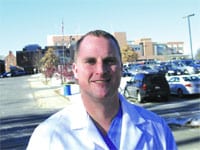Surgical Precision Cooley Dickinson Hospital Offers a Robotic Option for Hysterectomies
As Dr. Tucker Kueny sees it, he’s helping to usher in the future.
“I don’t have a crystal ball,” said Kueny, an ob/gyn and medical director of the Midwifery Program at Cooley Dickinson Hospital, “but looking 10 to 15 years down the road, I think this will be the standard of care. I think the benefits are that huge.”
He was speaking of the robotic da Vinci Surgical System, and specifically its uses in gynecologic surgeries, particularly hysterectomies, at CDH.
“There’s always some resistance to new technology, and always some degree of skepticism over whether or not it’s worth the expense, but I think those who actually use this platform almost immediately see its benefits and don’t want to go back to the way they were doing things before,” he said. “And I think the patients are excited to be part of something new and knowing they’ve had the most technologically advanced treatment available.”
In the U.S., Kueny explained, at least two-thirds of hysterectomies are done abdominally with a large incision, which results in a prolonged recovery for patients — a three- or four-day hospitalization and six weeks recovery, on average — not to mention the cosmetic result of that large incision.
Laparoscopic surgery, using smaller incisions and a tiny camera, have minimized some of that trauma and recovery time, but da Vinci, which employs robotic instruments that the doctor controls remotely, is another step of progress altogether.
“With laparoscopy in general, we’re able to do many of these surgeries with a much better recovery and much less pain, usually with one overnight stay,” Kueny said. “It’s a smaller incision and a better cosmetic result.
“What the da Vinci has done,” he continued, “is allow us to take some of the more complex surgeries that may have been very difficult to do laparoscopically in the past and make them possible to perform with this platform.”
Leap Forward
A hysterectomy is surgery to remove all or part of a woman’s uterus. There are several different types: a partial, subtotal, or supracervical hysterectomy removes just the upper part of the uterus, leaving the cervix in place; total hysterectomy removes the whole uterus and cervix; and radical hysterectomy removes the whole uterus, the tissue on both sides of the cervix, and the upper part of the vagina — a procedure performed mostly when cancer is present.
In all cases, after a hysterectomy, the patient no longer has menstrual periods and cannot become pregnant.
Depending on the health history of the patient and the reason for the hysterectomy, it can be performed through a 5- to 7-inch incision in the lower part of the abdomen; through a cut in the vagina; laparoscopically using three to four small cuts in the belly; laparoscopically through the vagina; or robotically.
There are several common situations that call for a hysterectomy, including cancer of the uterus, ovary, cervix, or endometrium; endometriosis; prolapse of the uterus; chronic pelvic pain; vaginal bleeding; and fibroids, which are non-cancerous, muscular tumors that grow in the wall of the uterus.
At Cooley Dickinson, the da Vinci robot is used not only for hysterectomies, but also a procedure called myomectomy, which removes fibroids while leaving the uterus intact.
The da Vinci robot was first used at Cooley Dickinson, as it is in most settings, for urological procedures and general surgery, but Kueny and his staff began to adapt it to gynecological surgeries soon after.
Nationally, the da Vinci robot is currently used for four ob/gyn procedures: hysterectomy and myomectomy; pelvic support procedures, which Kueny expects to become part of Cooley Dickinson’s treatment options as surgeons gain more experience; and treatment of gynecological cancers.
The latter treatment “is specific to gynecologic oncologists, and isn’t anything Cooley Dickinson plans to do, but it’s a huge area for surgeons,” he noted.
“We’re one of the few community hospitals that have the da Vinci platform, and it’s a big coup for a hospital this size,” Kueny continued, noting that, while other, larger hospitals in Western Mass. have da Vinci capabilities, CDH is the only community hospital in the region offering a robotic option for hysterectomy and myomectomy. “It’s those two main things so far, but this platform has potential for allowing us to do more types of open surgeries laparoscopically.”
Up Close
According to Intuitive Surgical, developer of the da Vinci technology, one drawback of conventional laparoscopy is that it relies on the use of rigid, handheld instruments and visualization provided by a standard 2D video monitor, which can limit the surgeon’s sense of depth of field, dexterity, and precision. In contrast, da Vinci provides a more natural depth of field in the monitor used by the surgeon, and allows his hand movements to be translated into precise micro-movements of tiny instruments at the operative site.
Despite misconceptions around the word ‘robot,’ da Vinci cannot perform any task on its own. Instead, the system is designed to seamlessly replicate the movement of the surgeon’s hands with the tips of micro-instruments. The system cannot make decisions, nor can it perform any type of movement or maneuver without the surgeon’s direct input.
Kueny can attest to better surgical outcomes due to the fact that the doctor has a more close-up, complete view of his field of work.
“With da Vinci, you have a degree of magnification and visualization that you’re not able to attain even with open surgery,” he told The Healthcare News. “There’s increased precision than with open surgery with decreased blood loss; the other advantage is that it leads to quicker patient recovery.”
One challenge now is to promote this option so that women are aware that they have another choice when it comes to hysterectomy.
“I think this is an option for most women,” he said. “Unfortunately, so many women see the doctor, and the doctor says they need an abdominal hysterectomy, and they don’t ask any questions, like, ‘is there a less invasive way to do this?’ They implicitly trust the physician, and it’s good to have that relationship, but I urge people to always ask those followup questions.”
If they do — or conduct a little research on their own — they might discover that the da Vinci system continues to raise its profile in the medical community.
“We’re fortunate to have this available in the community-hospital setting, and they don’t have to go to Boston or a tertiary hospital to get this sort of treatment,” Kueny said.
“The precision of these instruments is really quite amazing, what you can accomplish with them,” he added. “It’s not that we’re doing new procedures, but it’s making the procedures we do more precise, which makes my job so much easier and opens up the things we’re able to offer patients.”
All without opening up the patient any more than necessary — and sending her home faster than ever.



Comments are closed.